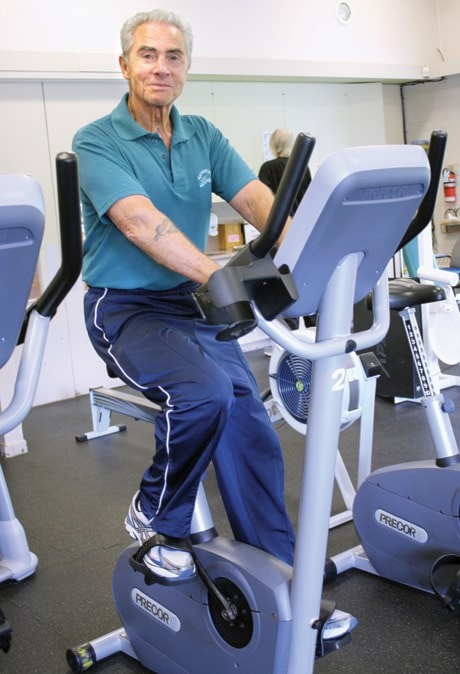Walking along scenic Dallas Road with his wife one November afternoon, Bob Martin grew worried when he felt his left foot oddly slapping against the pavement. A longtime personal trainer at Henderson recreation centre, and an active person most of his life, Martin thought he may be having a stroke.
As Martin returned home, his back and hamstrings grew sore. He stretched his limbs, and took a hot bath in hopes it would relieve the pain. It didn’t help.
When Martin came out of the bath, his feet were puffy; they felt similar to the bottom of a dog’s paw, Martin recalls.
“I went to bed and I said to my wife, ‘If anything happens in the morning call help. There’s something happening with my body.’”
The next morning, on Nov. 2, 2010, Martin was taken to Victoria General Hospital, where he remained in the intensive care unit for five months. In order to breathe, he relied on a ventilator, and at times he had to be fed through a tube in his stomach.
Martin, now 74, was diagnosed with Guillain-Barre Syndrome (GBS), a rare disorder that attacks the body’s nerves causing paralysis.
The cause of Martin’s ailment was a flu shot – he was experiencing a “bad reaction” to an injection he received less than two weeks earlier.
Martin became completely paralyzed within two weeks of hospitalization. The paralysis slowly crept up from his legs to his knees, to his waist, and to his lungs. All he could feel was numbness and tingling throughout his body. All he could move were his eyes.
Martin recalls laying in his hospital bed, unable to move and feeling like a mummy.
“I felt like I was just encased in paper mache,” he says, describing the torment.
He remembers watching people “float” by his room, and being envious of their ability to walk.
“I would sit there and say, ‘Why can’t I walk?’”
After eight months in the hospital, including time in the neurological ward and almost two months in rehab, Martin returned home..
He couldn’t wait to get out of the hospital – he spent rehab sessions hiding his pain, convincing his physiotherapist that he could handle more.
“It was very, very painful, but I wouldn’t let her know,” Martin says. “I just tolerated it.”
Gradually, he regained his ability to walk, first by using a walker and then a cane.
Although Martin could barely walk on his own when he was discharged from VGH, that same day he was back in the gym at Henderson Recreation Centre.
“I came to work out,” he says with a smile.
Today, Martin can still be found in the gym at Henderson, where he returned to work part time in May.
Whether he’s chatting with clients in the fitness room or working on his own exercise routine, Martin seems right at home in the gym.
“When you come back, and come back to something that you love to do, it’s a freedom – work is a freedom,” he says, grinning. “And it’s a pleasure to be in the environment of people and having the opportunity to help others.”
Although Martin can now breathe and walk on his own, he isn’t without challenges. It’s the little things, such as buttoning a shirt, tying a tie, or fastening shoelaces that Martin struggles with – there’s a lack of flexibility from his elbows to his fingertips.
Walking uphill and on rocky surfaces also proves difficult because he can’t contract his toes.
“I’m still in recovery. From my knees down I have still a lot of numbness and very poor balance,” Martin says.
To improve both his balance and flexibility, he works out six days a week, focusing on cardio and lifting light weights.
Martin’s damaged nerves can only be restored through time. The nerves from his neck to the tip of his toes heal about one millimetre a day, or about three centimetres each month. The length of Martin’s nerve damage is about one metre.
“Hopefully, in another year I will be as good as new, but there’s no guarantee,” he says. “There’s no guarantees that the nerves will regenerate completely and not leave you with some kind of deficit.”
Growing up, Martin was always active. The Regina native played a variety of sports, including hockey, basketball and baseball. He even competed in track and field with the Victoria Flying Y Club in the late 1970s and ’80s.
Finding a career in fitness seemed natural to Martin, who has been a personal trainer for more than 20 years.
Had Martin not had the active lifestyle he did before being diagnosed with GBS, he believes he wouldn’t be alive today.
“I would probably not have lived through the GBS,” he says. “I probably would have died.”
Having experienced life as a quadriplegic, Martin says he now sees people with disabilities in a new light – he understands what life for them is like. He also has a different outlook on life.
“You can find a little fun and a little happiness in not being too serious in your daily life,” he says.
One of Martin’s favourite pastimes is golf, a sport he’s enjoyed since well before contracting GBS.
Although he still can’t play a full 18 holes, he’s excelling on small courses, he says.
“When I play that small course, I’m playing it as good or better than I did before. I’m hoping my short game in golf will become better. Maybe that’s one of the reasons why I got (GBS), I have to improve my short game,” he says with a laugh.
To read more about Martin’s story, told by his wife and daughter, visit ramgbs.wordpress.com.
